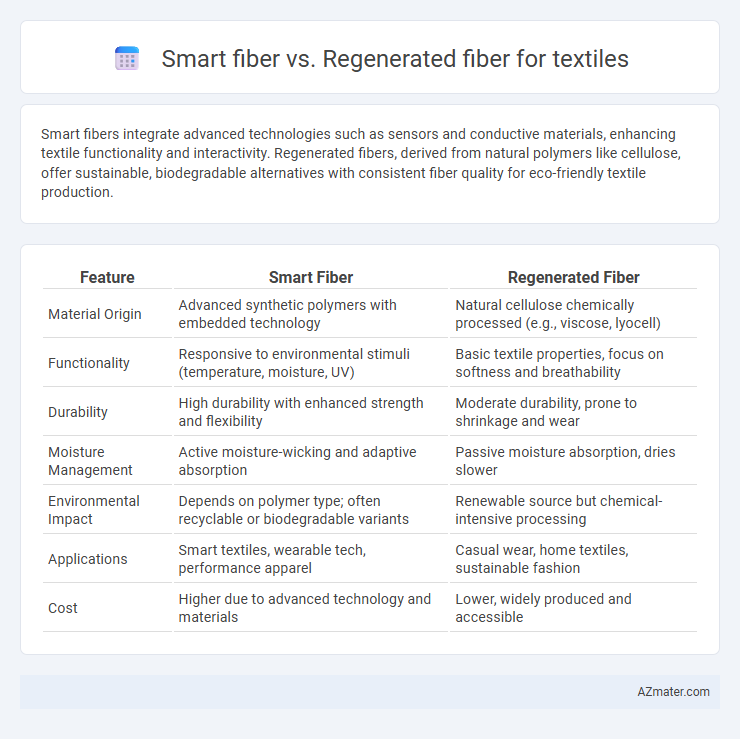Smart fibers integrate advanced technologies such as sensors and conductive materials, enhancing textile functionality and interactivity. Regenerated fibers, derived from natural polymers like cellulose, offer sustainable, biodegradable alternatives with consistent fiber quality for eco-friendly textile production.
Table of Comparison
| Feature | Smart Fiber | Regenerated Fiber |
|---|---|---|
| Material Origin | Advanced synthetic polymers with embedded technology | Natural cellulose chemically processed (e.g., viscose, lyocell) |
| Functionality | Responsive to environmental stimuli (temperature, moisture, UV) | Basic textile properties, focus on softness and breathability |
| Durability | High durability with enhanced strength and flexibility | Moderate durability, prone to shrinkage and wear |
| Moisture Management | Active moisture-wicking and adaptive absorption | Passive moisture absorption, dries slower |
| Environmental Impact | Depends on polymer type; often recyclable or biodegradable variants | Renewable source but chemical-intensive processing |
| Applications | Smart textiles, wearable tech, performance apparel | Casual wear, home textiles, sustainable fashion |
| Cost | Higher due to advanced technology and materials | Lower, widely produced and accessible |
Introduction to Smart and Regenerated Fibers
Smart fibers integrate advanced technologies such as sensors and conductive materials to enable responsive and adaptive textile properties, revolutionizing wearables and technical fabrics. Regenerated fibers, derived from natural polymers like cellulose through chemical processes, offer sustainable alternatives with softness and durability comparable to natural fibers. Both fiber types are transforming the textile industry by combining innovation with environmental consciousness.
Defining Smart Fibers in Textiles
Smart fibers in textiles are advanced materials engineered to respond dynamically to environmental stimuli such as temperature, moisture, and light, enhancing fabric functionality beyond traditional uses. Unlike regenerated fibers, which are derived from natural polymers regenerated through chemical processes like viscose or lyocell, smart fibers integrate sensors or actuators to provide features like moisture management, UV protection, or shape memory. These innovations position smart fibers at the forefront of technical textiles, targeting applications in sportswear, medical textiles, and adaptive clothing.
Understanding Regenerated Fibers
Regenerated fibers, derived from natural polymers like cellulose, are chemically processed to enhance fiber consistency and durability, making them ideal for textile applications where softness and moisture absorption are critical. Smart fibers incorporate advanced technologies such as phase change materials or conductive elements to provide functionality like temperature regulation or sensing capabilities, but regenerated fibers remain essential for sustainable textile production due to their biodegradability and renewable origins. Understanding the chemical modification processes and fiber properties of regenerated fibers highlights their role in eco-friendly fabrics, contrasting with smart fibers' focus on performance and innovation.
Key Differences: Smart vs Regenerated Fibers
Smart fibers incorporate advanced technologies like sensors and conductivity, enabling interactive textile applications such as health monitoring and adaptive clothing. Regenerated fibers are produced by chemically processing natural polymers, such as cellulose, to create eco-friendly fibers like viscose and lyocell with high moisture absorption and comfort. The key differences lie in functionality, where smart fibers provide responsive features, whereas regenerated fibers focus on sustainability and traditional fabric performance.
Performance Characteristics Comparison
Smart fibers exhibit superior moisture management, thermal regulation, and durability compared to regenerated fibers, making them ideal for high-performance textiles. Regenerated fibers offer excellent biodegradability and comfort but tend to have lower tensile strength and slower drying rates. Advanced smart fibers incorporate nanotechnology for enhanced UV protection and antimicrobial properties, which are not typically found in conventional regenerated fibers.
Sustainability and Environmental Impact
Smart fibers, engineered with advanced technologies to enhance performance and durability, contribute to sustainability by reducing the need for frequent replacements and minimizing waste. Regenerated fibers, such as viscose and lyocell, are produced from natural cellulose sources and offer a biodegradable alternative to synthetic fibers, but their environmental impact varies depending on the production methods and chemical use. Choosing smart fibers with eco-friendly manufacturing processes can lead to significant reductions in water usage, energy consumption, and carbon emissions compared to conventional regenerated fiber production.
Technological Innovations in Smart Fibers
Smart fibers incorporate advanced technologies such as embedded sensors, conductive materials, and shape-memory capabilities, enabling real-time responsiveness and interactive textile applications. Regenerated fibers, derived from natural polymers through chemical processes, focus on sustainability but lack the integrated functionalities present in smart fibers. Innovations in smart fibers drive the development of wearable electronics, health monitoring systems, and adaptive clothing, revolutionizing the textile industry.
Applications in the Textile Industry
Smart fibers, integrated with sensors and conductive materials, enable advanced functionalities like temperature regulation, health monitoring, and UV protection, positioning them at the forefront of wearable technology and smart apparel. Regenerated fibers, such as viscose and lyocell, offer sustainable alternatives with excellent moisture absorption and breathability, widely used in eco-friendly fashion and home textiles. Textile industries leverage smart fibers for innovation in activewear and medical textiles, while regenerated fibers dominate in soft, comfortable, and sustainable clothing lines.
Market Trends and Future Prospects
Smart fiber technology in textiles is rapidly advancing, driven by increasing demand for adaptive and functional fabrics in wearable tech and healthcare markets. Regenerated fibers, such as viscose and lyocell, continue to grow due to sustainability trends and eco-conscious consumer preferences, offering biodegradable alternatives to synthetic fibers. Future prospects highlight a convergence where smart fibers integrate regenerative materials, enhancing performance while reducing environmental impact, positioning both sectors for sustained market expansion.
Choosing the Right Fiber: Factors to Consider
Selecting between smart fiber and regenerated fiber for textiles depends on factors such as sustainability, performance, and end-use requirements. Smart fibers offer advanced functionalities like moisture management, temperature regulation, and enhanced durability, suitable for technical and activewear applications. Regenerated fibers prioritize eco-friendliness by utilizing recycled or natural materials without compromising softness and breathability, making them ideal for sustainable fashion and everyday garments.

Infographic: Smart fiber vs Regenerated fiber for Textile
 azmater.com
azmater.com